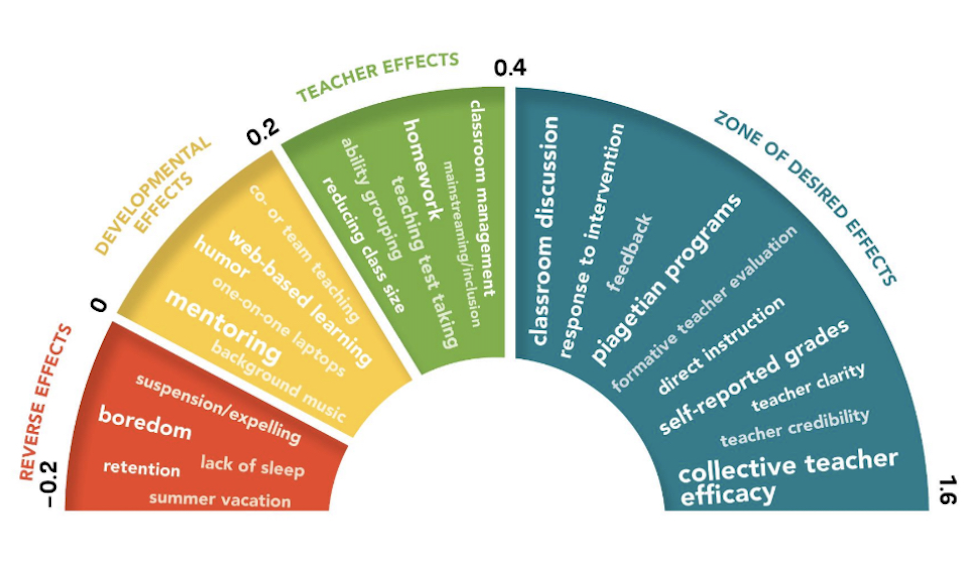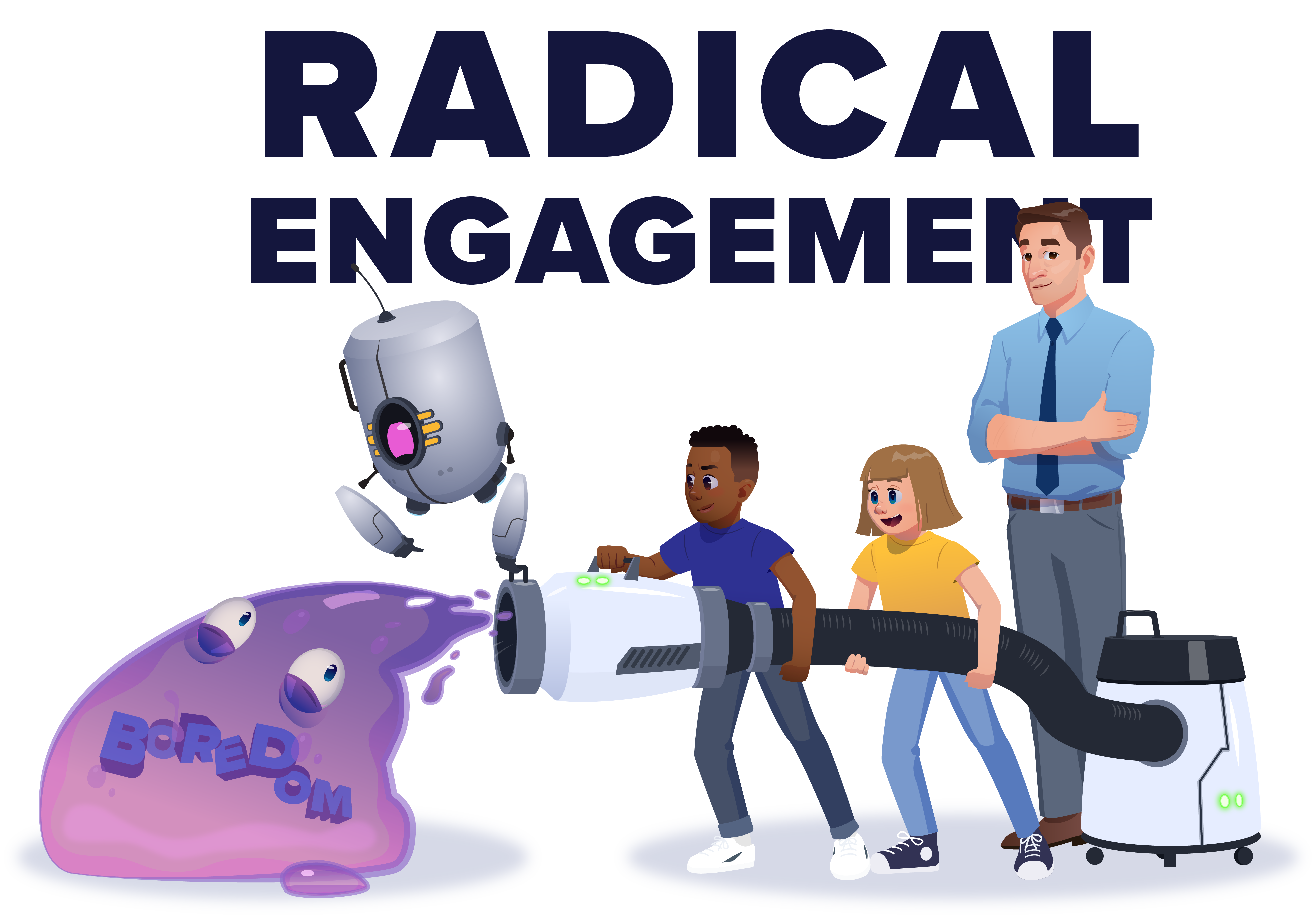Share this
Banishing Boredom with Radical Engagement
by Cameron Milien on September 26, 2023
Ah, the look. You know the one I'm talking about.
Their eyes glaze over like day-old doughnuts. They pull out their phones, swiping left on everything you’re saying despite your best attempts at keeping it interesting. Yeah, they’ve checked out, and you’ve lost them – at least for the time being. And you now feel really good about the lesson you spent hours of your own time prepping the night before.
Let me tell you, teaching really works wonders on the self-esteem. This profession is certainly not for the faint of heart. (Understatement of the year.)
.png?width=4810&height=2801&name=Take%20a%20Stand%20(no%20text).png)
I saw that look all too often over the years of teaching middle school and high school students. I hated that look and all the disengagement, apathy, and boredom that came with it, so I made it my goal to try to banish boredom from my classroom.
Why this matters
By now, most of you in the education world have probably heard of John Hattie’s often-cited Visible Learning research that has synthesized over 2100 meta-analyses in the last 25 years (including over 132,000 studies and 300 million students), exploring the factors that influence student achievement – for better or for worse.
Fun fact: he just released Visible Learning: The Sequel in March 2023, which builds on his original 2008 book. I haven’t read the sequel yet, but it’s on my wish list (#nerd). Hattie's most updated research is currently documented in a Global Research Database on the Visible Learning MetaX site (Corwin Visible Learning Plus, 2023).
For each of the 320+ factors Hattie identified, he calculated a score known as an “effect size” based on how that factor relates to student achievement. He found that the average effect size was 0.4, which represents an average year’s worth of growth for a student per school year. This means that any factor that has an effect size above 0.4 has greater than a year’s impact on student learning, and anything below 0.4 actually has a reverse (negative) impact on student learning.
Now, get ready to spit out your coffee: boredom has an effect size of -0.46, meaning it can actually lead to a LOSS of a year’s worth of academic growth.
And let me tell you something even more shocking: the only factors with a lower effect size than boredom are anger (-0.65), maltreated children (-0.63), pre-term/low birth weight vs. full term (-0.59), and illness (-0.51). And that includes significant things like physical syndromes (-0.42), anxiety (-0.40), bullying (-0.28), and suspension/expelling students (-0.20).
Yes, you read that right. Students being bored in school (-0.46) has a more negative effect on student learning than students being KICKED OUT of school (-0.20). 🤯
Boredom is a certified educational killer, outstripping other issues that you'd think would weigh more heavily on a student's academic progress. It's a silent force lurking in every classroom, waiting to pounce when you least expect it. It can have such a devastating effect on learning that we can't afford to ignore it any longer.
So, what's an educator to do? Roll over and accept defeat? NEVER.

Source: https://visible-learning.org/2022/01/hatties-barometer-of-influence-infographic/
7 Ideas to Spark Radical Engagement
Alright, teacher friends. So how do we tackle this elusive beast called boredom? The answer lies in radical engagement. Now, before you throw your whiteboard markers at me and claim I'm just throwing around buzzwords, hear me out. Radical engagement is all about creating an environment where students are so absorbed in the learning process that there's no room for boredom to creep in.
It's about fostering a culture of curiosity, challenge, and a little bit of organized chaos. I'm all about activities that get kids up and out of their seats, talking to each other passionately about things that matter.
#1: Ditch the Lecture
Long gone are the days when students were just empty vessels to be filled with knowledge. So let's kick off with the basic stuff:
Stop. Lecturing.
Immediately.
I obviously don’t mean to avoid direct instruction altogether. I mean to stop talking AT your students for large blocks of time and start engaging WITH them because students should be active participants in their own learning journey.
And be especially wary of the overuse of PowerPoints. There’s actually a lot of research out there right now showing that overuse of PowerPoints can lead to decreased engagement and learning outcomes. Also, Hattie's research shows that traditional lectures have an effect size of -0.35, so watch out, lecture-loving teachers. The evidence is not in your favor.
Flip your classroom, try inquiry-based learning, or jump on the project-based learning bandwagon. When I was teaching AP Psychology, I flipped my classroom and completely threw out traditional lecturing (which is quite unheard of in the AP world), but it worked and made me a better (and more sane) teacher. Maybe that wouldn’t work for your teaching style or specific group of students, but give something new a try this year.
Your students will thank you later.
#2: Gamify the Experience
Nothing gets students' neurons firing like a little competition. Incorporate elements of game design in your teaching. You'd be amazed how quickly students perk up when there’s a reward on the line—even if it’s just bragging rights.
Check out gamified experiential learning platforms like Infini-D Learning for easy and effective ways to engage your students in authentic, collaborative problem-solving.
#3: The Power of Choice
Choice is empowering, especially for students who feel disconnected from their educational experience. Allow them to choose project formats, essay topics, or even seating arrangements (if that wouldn’t lead to a total classroom meltdown). You’d be surprised how a little autonomy can rev up a student’s desire to participate.
#4: Real-World Connections
Context is king. Relate figurative language to popular song lyrics, connect the Pythagorean Theorem to architecture, discuss the physics behind a student's favorite sport, or examine the historical roots of the latest social media trend. The more you can link your curriculum to the world beyond the classroom, the more engaged your students will be.
Trust me, they'll start seeing your subject everywhere, and there’s nothing like a “Aha! I get it now!” moment to make your teacher-heart proud.
#5: Emotional Investment
Building relationships with your students isn't just a feel-good exercise; it's foundational for radical engagement. Show an interest in their lives, their struggles, their strengths, and their weaknesses. When students know you care about them, they're more likely to care about what you're teaching.
#6: Celebrate the Small Wins
Big milestones are great, but don't underestimate the power of celebrating small wins. Got through a tough lesson? High-five! Someone improved their grade? Fist bump! Celebrating these moments not only boosts morale but also creates a positive feedback loop that motivates students to strive for more.
#7: Keep Innovating
What worked yesterday won’t necessarily work today, let alone tomorrow. The key to sustained engagement is adaptability. Listen to your students' feedback, assess what's working and what's not, and be willing to pivot as needed.

The Bottom Line
Radical engagement is a lifestyle choice for educators who are committed to squeezing out every last drop of potential from their students. So, folks, if you're as fed up with boredom and disengagement as I am, it's time to roll up those sleeves and do something about it.
Transform your classroom into an exciting place where curiosity thrives, challenges are conquered, and boredom is banished to the land of obsolete overhead projectors and chalk dust.
References
Corwin Visible Learning Plus (2023, June). Global Research Database. Visible Learning Meta. Retrieved September 26, 2023, from https://www.visiblelearningmetax.com/Influences
Share this
- December 2025 (3)
- November 2025 (1)
- October 2025 (4)
- September 2025 (2)
- August 2025 (6)
- July 2025 (9)
- June 2025 (8)
- May 2025 (6)
- April 2025 (4)
- March 2025 (4)
- February 2025 (1)
- May 2024 (1)
- March 2024 (1)
- February 2024 (1)
- January 2024 (3)
- November 2023 (1)
- October 2023 (1)
- September 2023 (4)